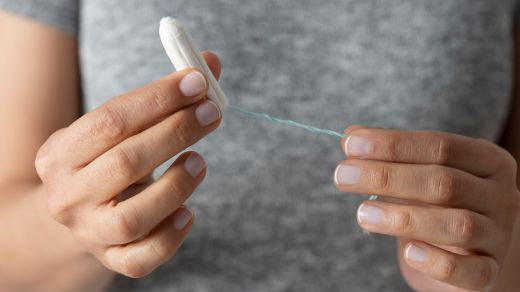Toxic shock syndrome (TSS) is a rare infectious disease mainly caused by streptococci and staphylococci. If left untreated, there is a risk of dangerous multi-organ failure. Which causes of TSS are known and which symptoms should be treated with caution.
- © Getty Images/simarik
Quick Reference: Toxic Shock Syndrome (TSS)
What is Toxic Shock Syndrome? It is a multiorgan disease caused by toxin-forming bacteria. In individual cases there is a connection between tampons and TSS, hence the colloquial term tampon disease.
Symptoms: The main symptoms are fever, drop in blood pressure and skin rash. If left untreated, TSS can lead to organ failure.
Causes: The disease is caused by infection with bacteria of the genus Streptococci and Staphylococci. The body reacts to toxins produced by the respective bacterium.
Diagnosis: Anamnesis, physical examination, vaginal swab to detect the pathogen and blood test
Treatment: Rinse infected area, give antibiotics and immunoglobulins
Article content at a glance:
What is Toxic Shock Syndrome?
In toxic shock syndrome (TSS), the body reacts to poisons (toxins) from the bacteria Staphylococcus aureus and Streptococcus pyogenes. Most often it is the toxin TSS toxin 1 (TSST-1). In general, experts distinguish between menstrual and non-menstrual TSS, i.e. when the shock syndrome occurs during menstruation or at another time.
Symptoms of Toxic Shock Syndrome
Different symptoms appear as the disease progresses. The following symptoms are typical of the acute phase of shock:
- sudden high fever (over 39°C)
- Drop in blood pressure up to hypotension (blood pressure values below 100/60 mmHg)
- Rash resembling a sunburn
Depending on the organs involved, numerous symptoms can indicate TSS:
Causes of Toxic Shock Syndrome
In most cases, young women between the ages of 15 and 20 are affected by toxic shock syndrome. Since there are always cases in which women fall ill during menstruation and when using tampons, tampons are considered risk factors for TSS.
Leaving the tampon in the vagina for too long can encourage the growth of toxin-producing bacteria. This is especially true for very absorbent models. Individual cases of TSS when using menstrual cups are now also known.
Overall, however, the risk of toxic syndrome from tampons or menstrual cups is classified as very low. Nevertheless, manufacturers of hygiene products provide information in their leaflets about the dangers of TSS and what measures can be taken to minimize the risk.
Causes of Nonmenstrual TSS
Wounds from childbirth, miscarriage, and surgical procedures can become potential entry points for bacteria, so they are considered risk factors for nonmenstrual TSS. Wearing a diaphragm for too long or leaving a contraceptive cap in the vagina for too long can also promote toxic shock syndrome.
Possible risk factors:
- previous skin and soft tissue infections
- burns
- respiratory infections
- previous births and abortions
- Wounds from surgical interventions
Diagnosis of suspected TSS
If a sudden fever and other symptoms of TSS occur, those affected should consult a doctor immediately or call the emergency number – depending on their condition. First of all, the anamnesis is carried out, in which the existing symptoms are determined. It is important to indicate whether those affected were using a tampon, a menstrual cup or a diaphragm at the time of the symptoms.
This is followed by a physical examination, blood pressure measurement and, if necessary, a blood test in the laboratory. Here, the serological detection of TSST-1 antibodies can take place. However, the majority of people already have corresponding antibodies in their blood through previous contact with Staphylococcus aureus. A swab from the vaginal mucosa, which is examined for TSST-1-producing staphylococci, is also possible.
Treatment of Toxic Shock Syndrome
If not already done, personal hygiene items such as tampons or vaginal contraceptives are removed from the vagina to eliminate the possible source of the infection. In addition, the infected area is rinsed and cleaned with water.
Subsequently, saline fluid is usually administered intravenously and, if the blood pressure drops, medication is given that raises the blood pressure again. Antibiotics are also used to stop the bacterial infection. Intravenously administered immunoglobulins (antibodies) can neutralize the toxin of the bacteria. In order to prevent serious complications, those affected are usually admitted to the hospital for observation.
Recommendations for the prevention of TSS
In order to reduce the risk of toxic shock syndrome, careful menstrual hygiene is particularly important during the period.
Preventive Tips:
Only insert and remove hygiene products with washed hands.
Select tampon size according to current bleeding intensity. The motto is: as small as possible and large as necessary.
Change the tampon more frequently (3-6 hours) if bleeding is heavy and less frequently (6-8 hours) if bleeding is light.
Remove the tampon after eight hours at the latest.
Thoroughly wash blood out of the menstrual cup.
Boil the menstrual cup, storage container and diaphragms at the end of your period.
Replace the menstrual cup and diaphragm with new products if there is an unpleasant smell.
If toxic shock syndrome was caused by a tampon infected with staph, recurrence of infection is common if tampons continue to be used. The course is then usually milder than with the first infection. Nevertheless, women who have recovered from TSS should then avoid using tampons, menstrual cups, diaphragms or vaginal contraceptive caps and switch to other hygiene products or contraceptives.


